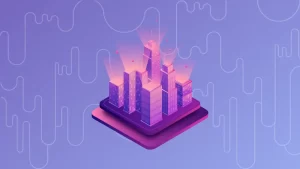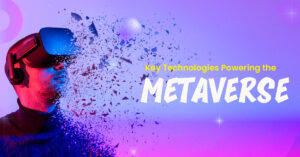The concept “metaverse” has quickly become one of the most debated ideas in the field of technology, particularly when companies like Facebook have rebranded themselves as Meta. What exactly is the metaverse, and why does it generate so much interest? The metaverse is a virtual universe that blends elements of virtual reality, augmented reality, and the Internet. It’s an immersive environment where users can interact with digital worlds with other online users at the same time. Although the metaverse may seem like science fiction, it’s founded on actual technological advances that are designed to transform the way we do business, live, and play.
The Evolution of the Digital World:
To comprehend the metaverse, it’s helpful to consider how the internet has changed. In the beginning, the internet was mostly static. You could browse websites and read articles; however, there was no interaction. It was then that we got Web 2.0, which allowed for more dynamic content and increased user interaction. Think of social media platforms, videos, and social media platforms, as well as live chats. Metaverse is the next phase, commonly called Web 3.0. The new stage aims to provide a completely immersive, 3D digital world where users can interact with friends, play games, attend gatherings, and even create virtual assets or real property.
Virtual and Augmented Reality as Building Blocks:
The two main technologies that are powering our metaverse include virtual reality (VR) and augmented reality (AR). Virtual reality creates a fully digital world that people can experience using headsets such as the Oculus Quest and HTC Vive. Everything you see and experience in VR is created by computers, allowing an immersive experience. However, augmented reality overlays digital elements on the real world, typically using phones and AR glasses. Each of VR as well as AR is essential to create the feeling of “presence” that makes the virtual world feel real and exciting.
Interacting Inside the Metaverse:
One of the main characteristics that make up the metaverse is its possibility of interacting with other people by using digital avatars. The avatars represent 3D representations of people and can be personalized to reflect their personality or character. Within this metaverse, you can enjoy concerts, hang out with your friends, wander through virtual cities, or shop. The interactions are more real as compared to traditional platforms due to the immersive experiences created by AR and VR. For many, VR and AR are about being a part of the digital world, where the possibilities are virtually endless.
Economic Opportunities in the Metaverse:
Another intriguing part of metaverses is their potential economic value. Like in actual life, consumers can purchase and sell goods and services. Virtual currencies, as well as NFTs (non-fungible tokens), play an important role in this. NFTs are unique digital products that can be used to represent everything from artwork to clothing. It is possible to earn money by making, selling, or trading NFTs. A few companies are already building virtual stores, purchasing virtual real estate, or hosting paid events in the virtual world. The digital economy may provide new employment opportunities, and business models are only beginning to be understood.
The Role of Big Tech Companies:
The tech giants have been investing heavily in the metaverse. The transition of Facebook to Meta is a prime example. Microsoft, Apple, Google, and other companies are also developing platforms and tools to create the digital world. They are creating VR/AR gadget software as well as cloud infrastructure that will support these vast, interactive environments. While the competition is fierce, collaboration is also essential because the metaverse relies on interoperability–meaning users should be able to move their avatar and digital items seamlessly between different virtual worlds.
Challenges and Concerns:
While the metaverse may sound exciting as it is, it also has its issues. Security and privacy are the main security concerns. Since the metaverse monitors users’ movements, actions, and interactions much more thoroughly than other platforms, there’s the possibility of even more data being collected. There’s also the possibility of digital addiction, where users may prefer to live in a virtual reality over the real world. There are also concerns about online safety, digital ownership, and fair access. As the metaverse expands, developers, corporations, and government officials will have to deal with these issues to ensure that it’s a secure and accessible space for everyone.
How the Metaverse Could Change Daily Life:
The metaverse isn’t just for games or having fun. This entity is capable of influencing daily routines. For example, workplace meetings may be held inside virtual rooms, thereby making remote work more enjoyable. Schools could provide an immersive learning experience, such as exploring historical sites or space. Health care could benefit from remote therapy sessions or operations by using sophisticated simulations. Metaverse technologies could enhance socializing, education, entertainment, and fitness routines. The boundary between the digital and physical worlds will remain blurred as more experiences and services transform into virtual worlds.
Who Can Access the Metaverse Today:
Access to the metaverse is restricted, mostly due to the fact that it usually requires expensive devices like VR headsets. There are, however, platforms that provide simpler web-based, mobile-friendly environments. Games such as Roblox, Fortnite, and Minecraft are the earliest instances of metaverse-like places in which users collaborate with each other, create new experiences, and share them. In the future, as technology becomes cheaper and more accessible, more people will be able to participate in the metaverse and discover the possibilities it offers.
The Future of the Metaverse:
The metaverse is in its beginnings, but no one can determine exactly what it will look like. But its appearance will play an important role in the development of internet technology. As technology and the metaverse grow, they will become more complex, inclusive, and valuable. The vision is a shared and persistent digital universe that is a mirror of the real world, but with more possibilities. It will change the way we communicate and learn, work, and live our lives. Currently, staying current and adapting to potential metaverse changes is the most efficient approach.
Conclusion:
The metaverse is a bold concept for the next generation of interaction. It’s more than an intriguing trend or buzzword. It’s an entirely new way to interact with technology and one another. Through the combination of virtual reality, augmented reality technology, and blockchain technology, the metaverse is a digital world that can revolutionize the ways we communicate, work, entertain, and much more. Despite the challenges ahead, the current progress is encouraging. As we advance, the metaverse could very well be a part of our lives, like the internet currently is.
FAQs:
1. Do I need to enter the metaverse?
To fully experience the metaverse, you’ll require the VR headset as well as a device that has a reliable internet connection. Certain platforms, however, allow access via a smartphone or laptop.
2. Are gamers the only ones who use the metaverse?
The metaverse doesn’t stop there. It extends beyond gaming. It can help with business, education, social interaction, virtual tourism, and much more.
3. Can I earn money from the metaverse?
Indeed, the metaverse offers digital products, NFTs, virtual real estate, and other services that allow users to earn money.
4. Does the metaverse seem secure?
The security of the metaverse relies on how it is created and controlled. Similar to other websites, the metaverse is also prone to dangers like data breaches and cyberbullying; therefore, it is recommended to be cautious.
5. Does the metaverse have the potential to replace reality?
The metaverse is intended to enhance, not replace, reality. This text presents various methods of interaction, but the fundamental aspects of life will always remain significant.




